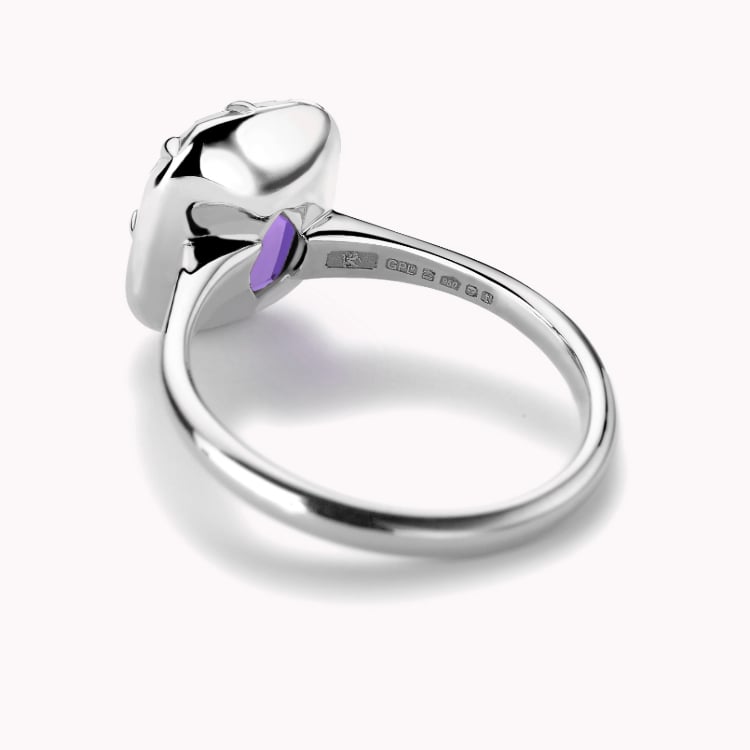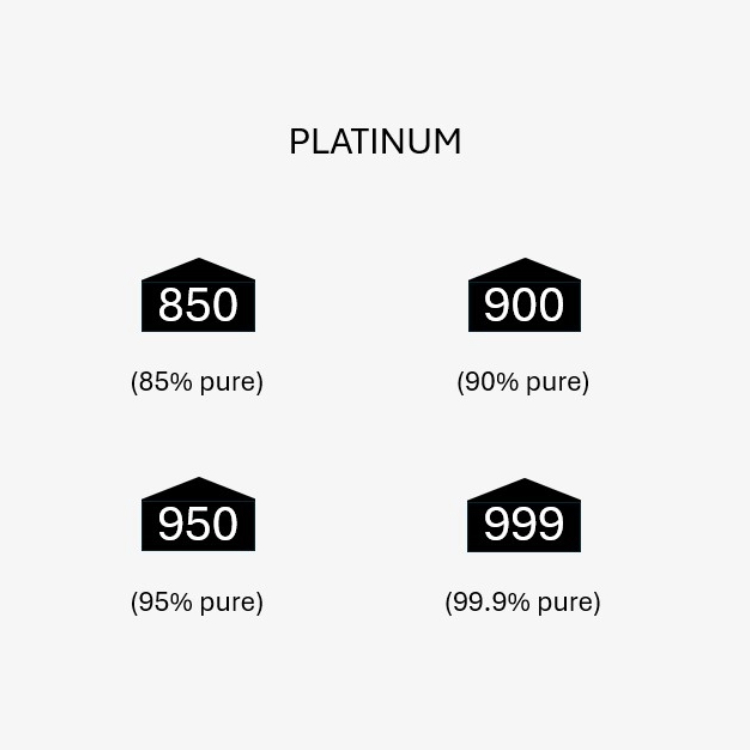Platinum Hallmarks: The Complete Guide
Platinum hallmarks play a vital role in verifying the authenticity, purity, and origin of platinum jewellery. These official marks are a legal requirement in the UK and serve as a guarantee that a piece has been independently tested and certified to meet strict quality standards. For both buyers and collectors, understanding platinum hallmarking is essential to ensuring the integrity and long-term value of a purchase.
This guide offers a comprehensive overview of platinum hallmarks, including the compulsory marks required by UK law, optional marks that provide additional provenance, and practical advice on how to identify them.
.jpg)
What is a Platinum Hallmark?
A platinum hallmark is an official stamp that guarantees the authenticity and purity of platinum used in jewellery. Hallmarking is a legal requirement in the UK for all platinum jewellery manufactured and sold in the UK since 1975, ensuring that your piece meets the necessary standards. This stamp confirms that the platinum has been assessed by professionals at an assay office, providing transparency and confidence in its quality.
At Pragnell, we ensure that all of our platinum jewellery is hallmarked by the most respected UK assay offices, giving you peace of mind with every purchase.
Historical Context of Platinum Hallmarking
The practice of hallmarking platinum was introduced in 1975, following the establishment of The Hallmarking Act of 1973. Before the act, platinum items were marked with either "Pt" or "Plat". While older pieces might indicate the use of iridium with "PLAT/IRID" or gold with markings like "18/Pt".
Platinum hallmarking aimed to guarantee the purity and authenticity of platinum jewellery as it gained popularity. With strict regulations now in place, platinum is one of the most highly regulated metals in the jewellery sector. Official assay offices certify its purity, providing transparency and confidence for buyers to ensure they are purchasing genuine platinum pieces.
The Three Compulsory Platinum Marks
In the UK, platinum jewellery must feature three compulsory marks to ensure that the platinum is of the highest quality and meets legal standards. These marks are required by UK hallmarking regulations.

Sponsor Mark
The Sponsor Mark identifies the maker or supplier of the jewellery. It typically displays the initials of the jeweller or company responsible for the piece. This mark ensures traceability and accountability, allowing you to trace the piece back to its maker for verification and transparency.

Millesimal Fineness Mark
The Fineness Mark on platinum jewellery indicates the purity of the metal used. In the UK, the standard fineness mark is 950, meaning that the piece contains at least 95% platinum. This mark guarantees the high purity of the platinum used in the jewellery, ensuring its quality and value. While marks of 900 and 850, while recognised in the UK, they are primarily seen on imported items.

Assay Office Mark
The Assay Office Mark indicates where the platinum jewellery was tested and verified for purity. In the UK, major assay offices include:
London – represented by a leopard’s head
Birmingham – represented by a horizontal anchor
Sheffield – represented by a Tudor rose
Edinburgh – represented by a castle
These marks ensure that the jewellery has passed a rigorous purity test, offering confidence in its authenticity and value. Additionally, they are often accompanied by a Date Letter, which denotes the year the piece was assayed.
Optional Platinum Hallmarks
Traditional Fineness Symbol
.jpg)
This optional mark consists of an orb with a cross on top, enclosed within a pentagon-shaped shield. It can appear alongside the Millesimal Fineness Mark and represents the traditional way of indicating platinum purity. It is often seen on older pieces and adds an extra layer of historical value. For collectors or those seeking heritage-rich items, this symbol enhances the piece’s authenticity.
Date Letter
.jpg)
The Date Letter marks the year the platinum was assayed, with a new letter corresponding to each year. This mark helps determine the age of a piece, making it especially valuable to collectors or those interested in the provenance of their jewellery. The Date Letter can also contribute to the item's value, especially in the case of vintage or limited-edition pieces.
International Convention Mark

The International Convention Mark signifies that the platinum jewellery meets internationally recognised fineness standards. This hallmark is essential when buying or selling platinum across borders, ensuring that the jewellery adheres to global quality regulations. It adds credibility to the piece, confirming its adherence to the best international standards for platinum purity.

How to Identify a Platinum Hallmark
Hallmarks are usually found inside rings, on clasps, or on the back of pendants. There are five platinum hallmarks. For items weighing more than 0.5 gram, the sponsor mark, the fineness mark, and the Assay Office mark are mandatory.
Check the Millesimal Fineness Mark: Look for the mark 950 (or 900 for imported pieces), which indicates the purity of the platinum.
Identify the Assay Office Mark: This symbol indicates where the platinum was tested for purity, such as London or Birmingham.
Look for the Sponsor’s Mark: This mark identifies the jeweller or manufacturer, ensuring traceability.
Optional Marks: Some pieces also include a Date Letter (indicating the year it was assayed) or an International Convention Mark, to show compliance with global standards.
Why Platinum is Highly Sought After
Platinum is a rare and highly valued metal, prized not only for its industrial uses, especially in the automotive and technology sectors but also for its enduring value in jewellery. When investing in platinum jewellery, it is essential to ensure that the piece is hallmarked. A hallmark guarantees that the platinum used is of the highest purity, providing confidence in the long-term value of your investment. At Pragnell, our platinum jewellery is expertly crafted and hallmarked to assure the highest quality and authenticity, making it a reliable investment for the future.
The tradition of platinum hallmarking represents a long-standing commitment to ensuring authenticity, purity, and quality in precious jewellery. These distinctive marks offer valuable insights into the origins and verification of platinum pieces, providing collectors, investors, and enthusiasts with the assurance that their jewellery is of the highest standard. By understanding and valuing platinum hallmarks, you not only safeguard the integrity of your jewellery but also protect its lasting value for generations to come.
Frequently Asked Questions
Below are the answers to our most commonly asked questions. Should you want to find out more please feel free to Contact Us and begin your Pragnell experience.
Jewellery CLP Page
Contact us